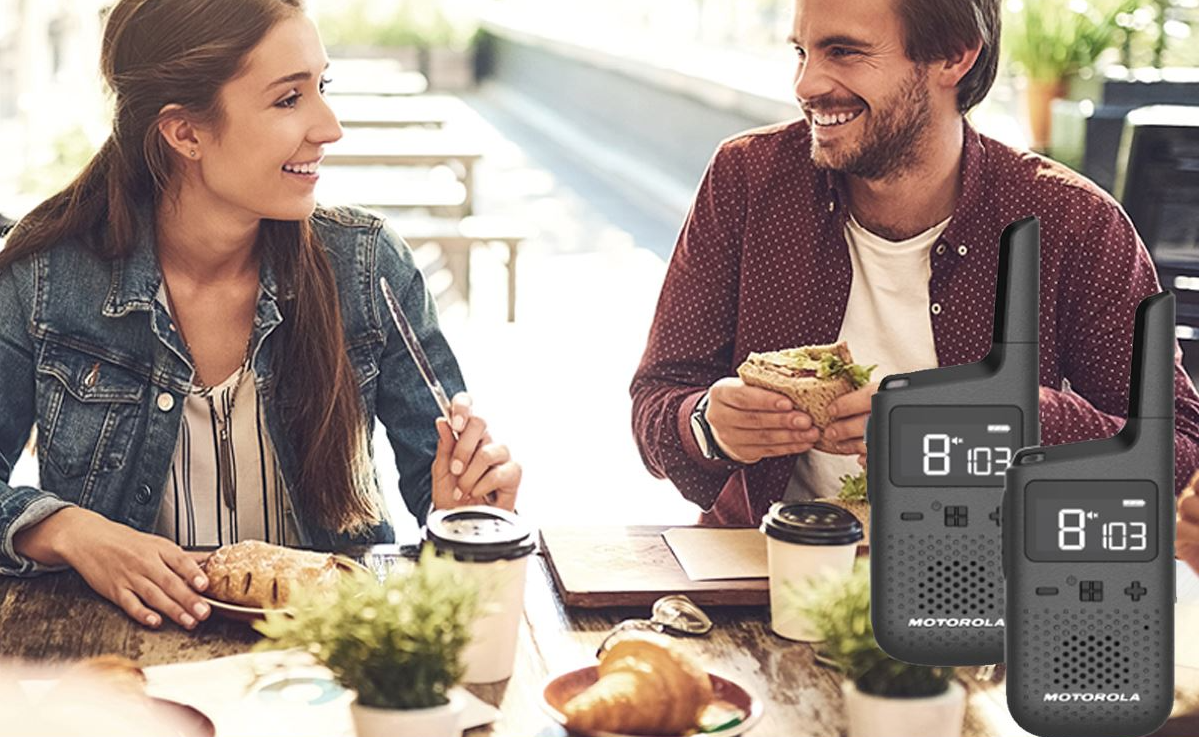motorola TALKABOUT Two-Way Radio T38
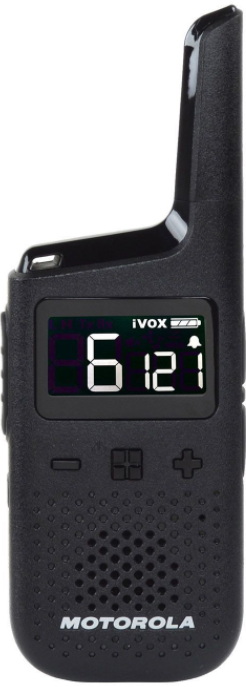

Getting to Know Your Radio
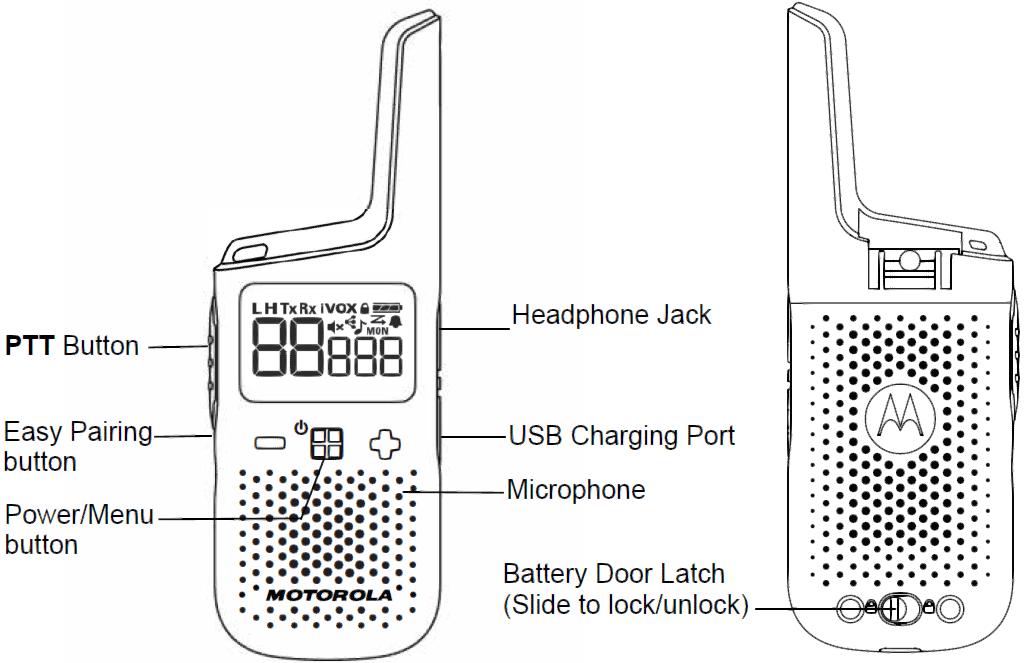

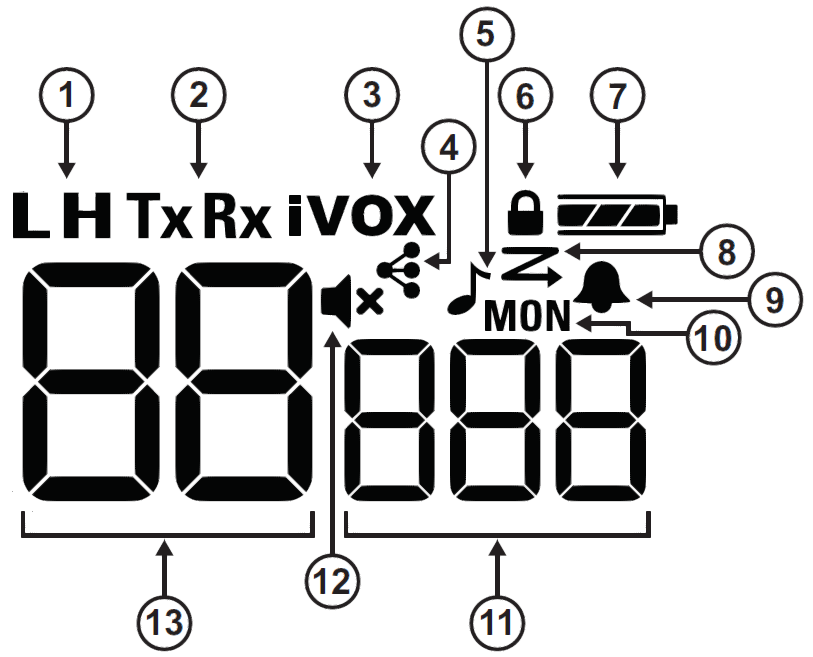

- High or Low Power
- Transmit or Receive
- VOX/iVOX
- Easy Pairing
- Call Tone
- Lock
- Battery
- Scan
- Roger Tone
- Monitor
- Code
- Mute
- Channel
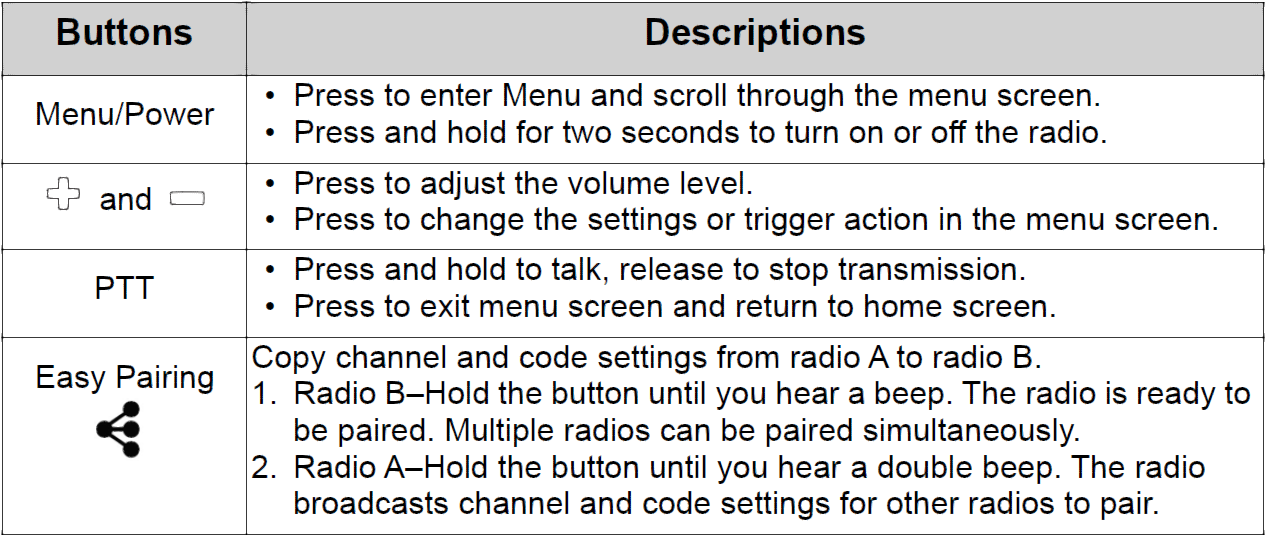

Additional Information
Internal Voice Operated Transmission (iVOX)/Voice Operated Transmission (VOX)The microphone detects if you are talking when using VOX/iVOX. If you are talking, the radio triggers transmission automatically.
- When iVOX is displayed, the radio uses the built-in microphone to detect your voice.
- When a VOX headset is connected to the radio, VOX is displayed and the headset microphone is used to detect your voice.
You can turn off or select the following settings to select the VOX/iVOX sensitivity level.
|
L3 |
High Sensitivity for quiet environments. Speaking softly is enough to trigger VOX/iVOX transmission. |
|
L2 |
Medium Sensitivity for most environments |
|
L1 |
Low Sensitivity for noisy environments. You must speak up to trigger VOX/iVOX transmission. |
Note: Pressing the PTT button cancels the VOX/iVOX transmission.
Setting up Your Radio
Installing and Charging the Battery
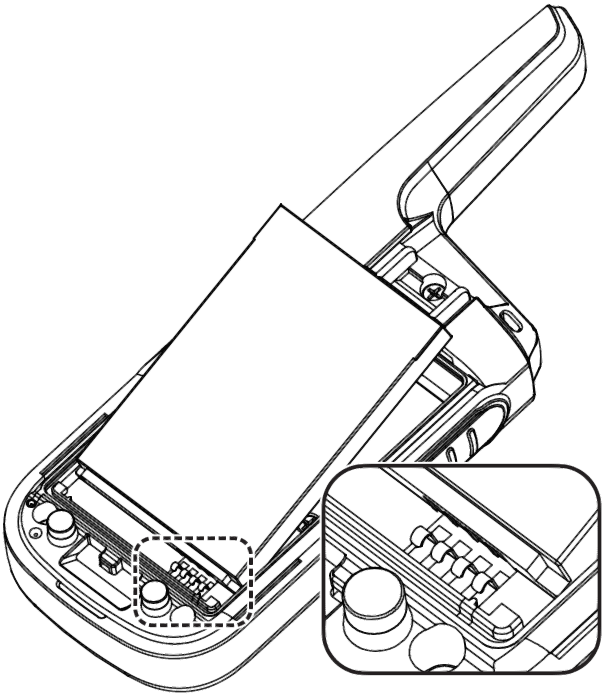

- Observe the polarity before installing the battery.
- Charge the battery using the desktop charger or USB. Charging is completed when the battery icon on the radio stops blinking. Charging takes up to 8 hours.
Inserting and Removing Belt Clip | Attaching Short Lanyard
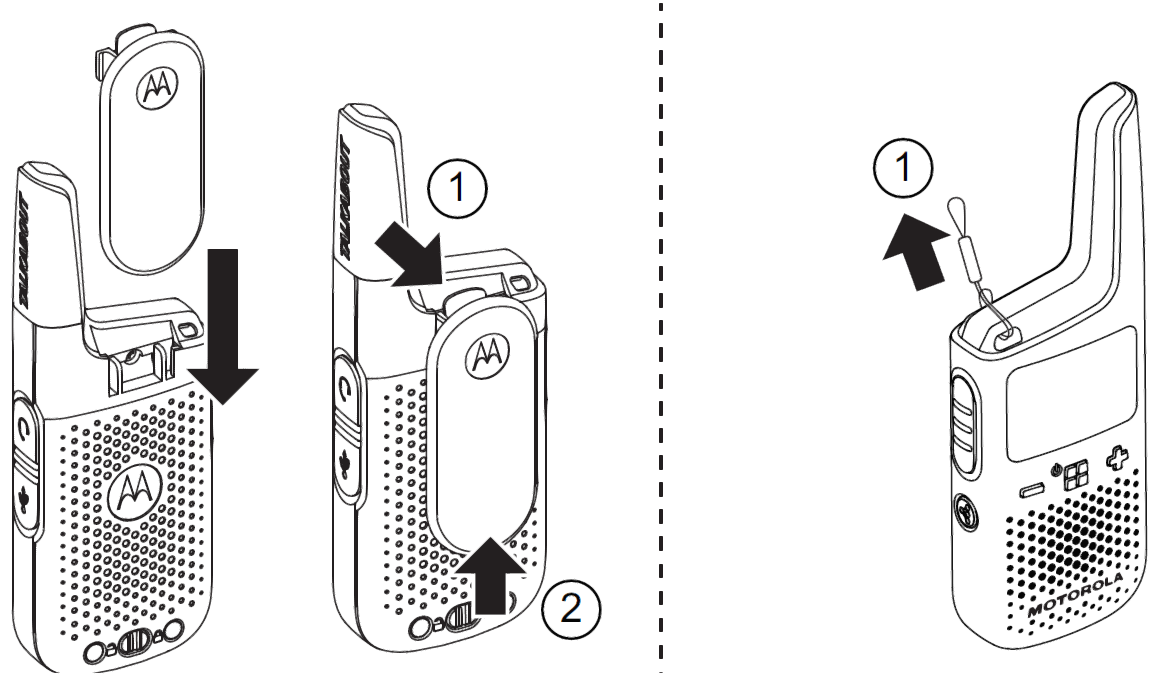

Turning your Radio On and Off
To turn the radio on or off, hold the Power/Menu button until the display turns on or off.
Channel and Codes
- Set your radios with the same channel and code setting to enable communication with other radios.
- The channel setting controls the radio frequency. To avoid jamming, select a channel that is not used by others in your area. See table in Section 3, “Scan” for more information on selecting unused channel.
- The code setting on the transmitting and receiving radios need to match, otherwise the receiving radio blocks the received signal. This feature helps you to mute unwanted voices from other radio users transmitting on your channel.
- When code is set to zero, radio does not block any signal and everything that is picked up on the channel is sent to the speaker. Motorola Solutions recommends setting your code to zero when using T38 with radios that do not support the code feature. See Section 3, “Navigating the Menu Pages” for detailed instructions on how to change settings.
- Channel and code settings can be copied from one radio to multiple radios simultaneously with a shortcut feature called Easy-Pairing. See table in Section 1, “Easy Pairing” for instruction on how to copy channel and code settings.
- Call ToneWhen you send a Call Tone, the receiving radio sounds a tone similar to phone ringing tone.
- ScanRadio scans for voice activity by cycling through the channels. When signals are detected, the signal is sent to the speaker. This feature allows you to find which channel is being used by other groups and have heavy traffic. This helps you to avoid the busy channels when deciding which channel to use for your group.
- MonitorYou can hear everything including noise on your current radio channel. This feature allows you to monitor a channel for weak signals.
- Roger ToneThis feature adds a beep to mark the end of a transmission when you release the PTT button. When the receiver hears the roger tone, it is a confirmation that complete message has been received.
- WeatherproofThis radio is weatherproof to IP54 standards. The radio is resistant to occasional splash of water only when the battery and connector covers are sealed. Do not expose the radio to water for extended period of time. Do not submerge the radio in water.
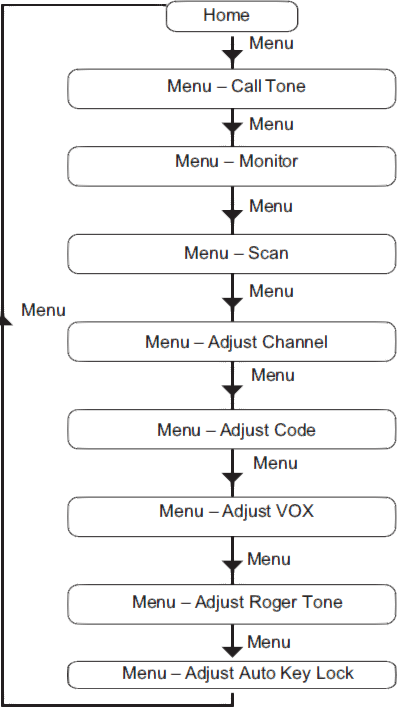

Use the Menu button to scroll through the menu screen. Press PTT to exit any screen and return to home screen.
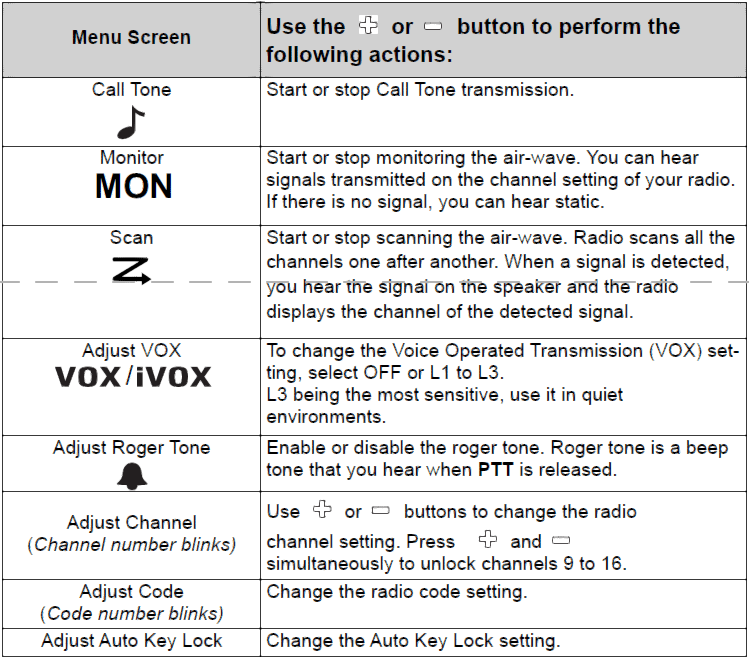

Battery Information
The rated battery life is measured under industrial standard 5-5-90 duty cycle under lab conditions. (5% of the time transmitting, 5% receiving with speaker on, 90% waiting for incoming call.)Caution: Use only Motorola Solutions approved batteries. Risk of explosion if the battery is replaced by an incorrect type.
Battery Capacity Maintenance
This radio comes equipped with a rechargeable Li-Ion battery. This battery should be fully charged before initial use to ensure optimum capacity and performance. Battery life is determined by several factors. Among the more critical are the regular overcharge of batteries and the average depth of discharge with each cycle. Typically, the greater the overcharge and the deeper the average discharge, the fewer cycles a battery will last. For example, a battery which is overcharged and discharged 100% several times a day, lasts fewer cycles than a battery that receives less of an overcharge and is discharged to 50% per day. Further, a battery which receives minimal overcharging and averages only 25% discharge, lasts even longer.Note: Connect the USB charger to a nearby and easily accessible wall power outlet.Note: Charge only Li-Ion type rechargeable batteries. Other types of batteries may burst, causing personal injury or damage. Turn off radio before charging.
Using Your Radio
Talking/Transmitting
- Press and hold the PTT button, then start talking into the microphone.
- Release the PTT button to stop transmission.
Note: Do not press the PTT button when others are talking. When more than one radio transmits on the same channel, the air-wave is jammed and all transmissions are lost.
Listening/Receiving
- The radio speaker receives signal automatically if radio is set to the same channel and code as the transmitting radio.
- Ensure the speaker volume is set to an appropriate level.
Adjusting Speaker Volume
- Press + or – from the home screen.
Auto Key Lock
- When Auto Key Lock feature is enabled, the 3 front buttons will be locked after 10 seconds of inactivity.
To unlock the 3 front buttons, press and hold any of them for 2 seconds.
Using Headsets
- When a headset is connected to the radio, radio speaker is disabled. You need to wear headset to monitor and receive messages.
- If your headset has PTT button, you can use the button to make a trans-mission with the microphone on the headset.
- You can still use the PTT button on the radio to make a transmission with the microphone on the radio.
Push-to-Talk Time-out Timer
To avoid air-wave traffic congestion, transmission ends after one minute even if the PTT button is still pressed. To reset the timer, release the PTT button briefly.
Channel and Frequencies
|
Channel |
Frequency (MHz) |
Channel |
Frequency (MHz) |
|
1 |
446.00625 |
9 |
446.10625 |
|
2 |
446.01875 |
10 |
446.11875 |
|
3 |
446.03125 |
11 |
446.13125 |
|
4 |
446.04375 |
12 |
446.14375 |
|
5 |
446.05625 |
13 |
446.15625 |
|
6 |
446.06875 |
14 |
446.16875 |
|
7 |
446.08125 |
15 |
446.18125 |
|
8 |
446.09375 |
16 |
446.19375 |
Note: Only Channels 1 to 8 are available by default. Channels 9 to 16 need to be unlocked by user before they can be selected. Channels 9 to 16 should only be used in countries where these frequencies are allowed by government authorities. Channels 9 to 16 are not allowed in Russia.
http://www.motorolasolutions.com/talkabout
MOTOROLA, MOTO, MOTOROLA SOLUTIONS and the Stylized M logo are trademarks or registered trademarks of Motorola Trademark Holdings, LLC and are used under license. All other trademarks are the property of their respective owners.
© 2021 Motorola Solutions, Inc. All rights reserved.



References
[xyz-ips snippet=”download-snippet”]

